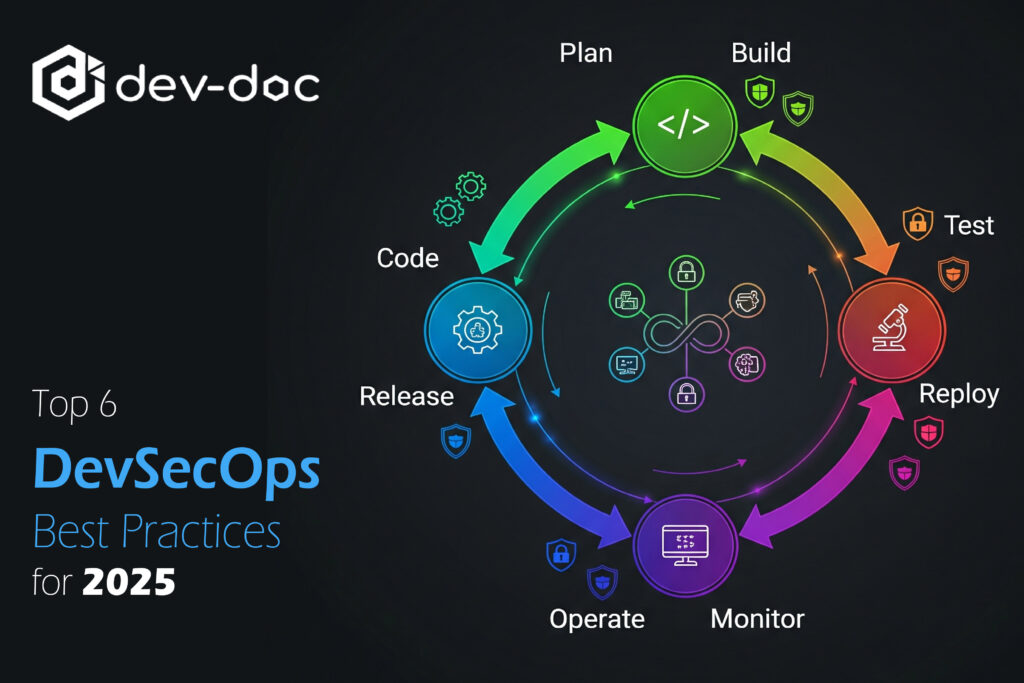In this article, we’ll briefly explore six effective best practices for DevSecOps.
What Is DevSecOps?
DevSecOps stands for Development, Security, and Operations, a methodology that implements security throughout the CI/CD pipeline rather than treating it as a separate stage after development.
In the traditional development process, security checks were performed at the end of the software development lifecycle. This “security at the finish line” approach often led to bottlenecks, last-minute fixes, and increased risk of vulnerabilities slipping into production.
DevSecOps fixes this with some effective approaches. Such as:
- Incorporating security from the earliest planning stages.
- Integrating tools that continuously scan code, dependencies, and configurations.
- Ensuring developers, security teams, and operations work together seamlessly.
This results in faster releases and fewer vulnerabilities.
Top 6 DevSecOps Best Practices
Have a quick look at 6 highly effective best practices for implementing DevSecOps.
Automate Security Testing in the CI/CD Pipeline
Automating security testing within a CI/CD pipeline involves integrating various security tools and practices throughout the software development lifecycle (SDLC) by continuous and automated code scanning and identifying and address code vulnerabilities early and efficiently.
Automated security testing can help you in the following areas:
- Significantly reduces the time and effort required for security testing.
- Ensures consistent testing across all code.
- Helps identify vulnerabilities early in the development cycle.
Implement Role-Based Access Control (RBAC)
Role-Based Access Control, or RBAC, is a security model where access to a system or data is controlled based on a user’s role within the organization, instead of assigning permissions to individuals directly. This enables centralized, scalable, and auditable access control.
How to Implement RBAC in DevSecOps:
- Define Roles and Responsibilities:
-
- Determine the different roles in the DevSecOps pipeline, such as developers, testers, security engineers, system administrators, and auditors.
- Clearly define tasks and responsibilities.
- Establish a hierarchy of roles based on the level of access and responsibility, such as administrator, manager, and user.
- Define Permissions
-
- Assign only the necessary permissions to each role. You can group permissions into categories based on resource types, such as read, write, execute, and delete.
- Associate the appropriate permissions with each defined role.
- Assign Users to Roles
-
- Assign users to the relevant roles based on their job function.
- Update role assignment when users transition to new roles or responsibilities. Implementing a mechanism for handling temporary or exception-based access needs can be helpful for managing exceptions.
- Monitor and Audit
-
- Conduct regular audits to verify and maintain RBAC configurations accuracy and up-to-date.
- Track user activity and identify potential security breaches by implementing the logging and monitoring mechanisms.
- Periodically review roles, permissions, and user assignments to ensure they align with evolving security needs.
Access control is critical in preventing unauthorized changes to code, systems, and infrastructure. It minimizes the potential impact of threats and compromised accounts.
Embed Security in Infrastructure as Code (IaC)
Infrastructure as Code, or IaC, is an essential part of DevSecOps, enabling automated and secured infrastructure management. It allows you to define infrastructure through code, which can be version-controlled, tested, and deployed alongside the application code, preventing insecure infrastructure from being deployed.
How to implement IaC in DevSecOps:
- Shift Security Left:
-
- Integrate security checks early in the IaC lifecycle
- Embed scanning in IDEs and CI/CD pipelines.
- Leverage Security as Code (SaC):
-
- Define policies and compliance rules as code
- Manage secrets securely.
- Implement IaC Scanning
-
- Use static/dynamic analysis tools and perform regular scans through CI/CD.
- Automate Security Tasks
-
- Automate secure deployments, scaling, and monitoring.
- Training & Awareness
-
- Provide hands-on security training with vulnerable environments and educate on best practices.
- Continuous Monitoring & Improvement
-
- Maintain incident response processes and refine security practices through feedback.
Implement real-time security monitoring
Real-time security monitoring involves monitoring applications and infrastructure continuously to detect and respond to threats as they occur. This proactive approach offers rapid identification and mitigation of security incidents, minimizing potential damage and downtime.
How to implement real-time security monitoring in DevSecOps:
- Integrate Security into CI/CD
- Use Advanced Monitoring Tools
- Automate Alerts & Incident Response
-
- Centralize alerts in dashboards, automate notifications, and follow predefined incident response protocols.
- Foster Collaboration
-
- Promote cross-team communication
- Maintain open channels for alerts
- Train teams on the latest security practices.
- Continuously Improve
-
- Conduct regular audits
- Perform threat modeling and risk assessments
- Keep incident response plans updated.
Shift Security Left
In short, shifting left means addressing security from the earliest stage of development. If your team is waiting until the QA or deployment phase, it might increase the cost and complexity of fixing issues. Shifting security left ensures vulnerabilities are detected before they reach production, saving time and reducing costs.
How to implement shift security left:
- Include security requirements in the design phase.
- Train developers to write secure code from day one.
- Perform threat modeling during initial planning.
Enforce Secure Coding Standards
Poor coding practices are a major source of vulnerabilities. Enforcing coding standards helps reduce risk from the start and the likelihood of introducing common vulnerabilities such as SQL injection or XSS.
How to implement enforce secure coding standards:
- Adopt secure coding guidelines like OWASP Secure Coding Practices.
- Use linters and code quality tools.
- Conduct peer code reviews with a security focus.
Final Thoughts
DevSecOps best practices aren’t optional now, they’re a competitive necessity. Teams that integrate security into every stage of their SDLC will be better positioned, delivering reliable, secure, and compliant products at speed.
If you’re just getting started with DevSecOps, begin with one or two best practices, such as Automate Security Testing or Implement Role-Based Access Control, and expand from there.
Documentations become essential at any stage of the SDLC. Tools like Dev-doc, Doxygen, and Document360 elevate the overall documentation process, making it easier to create, maintain, and update documentation that stays in sync with your project progress.
If you still have any questions or require any additional support. Feel free to contact us anytime.

